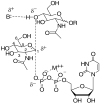Glycosyltransferase mechanisms: impact of a 5-fluoro substituent in acceptor and donor substrates on catalysis
- PMID: 17883281
- PMCID: PMC2556460
- DOI: 10.1021/bi700863s
Glycosyltransferase mechanisms: impact of a 5-fluoro substituent in acceptor and donor substrates on catalysis
Abstract
In glycosyltransferase-catalyzed reactions a new carbohydrate-carbohydrate bond is formed between a carbohydrate acceptor and the carbohydrate moiety of either a sugar nucleotide donor or lipid-linked saccharide donor. It is currently believed that most glycosyltransferase-catalyzed reactions occur via an electrophilic activation mechanism with the formation of an oxocarbenium ion-like transition state, a hypothesis that makes clear predictions regarding the charge development on the donor (strong positive charge) and acceptor (minimal negative charge) substrates. To better understand the mechanism of these enzyme-catalyzed reactions, we have introduced a strongly electron-withdrawing group (fluorine) at C-5 of both donor and acceptor substrates in order to explore its effect on catalysis. In particular, we have investigated the effects of the 5-fluoro analogues on the kinetics of two glycosyltransferase-catalyzed reactions mediated by UDP-GlcNAc:GlcNAc-P-P-Dol N-acetylglucosaminyltransferase (chitobiosyl-P-P-lipid synthase, CLS) and beta-N-acetylglucosaminyl-beta-1,4 galactosyltransferase (GalT). The 5-fluoro group has a marked effect on catalysis when inserted into the UDP-GlcNAc donor, with the UDP(5-F)-GlcNAc serving as a competitive inhibitor of CLS rather than a substrate. The (5-F)-GlcNAc beta-octyl glycoside acceptor, however, is an excellent substrate for GalT. Both of these results support a weakly associative transition state for glycosyltransferase-catalyzed reactions that proceed with inversion of configuration.
Figures






Similar articles
-
UDP-(5F)-GlcNAc acts as a slow-binding inhibitor of MshA, a retaining glycosyltransferase.J Am Chem Soc. 2010 May 19;132(19):6626-7. doi: 10.1021/ja101231a. J Am Chem Soc. 2010. PMID: 20411981 Free PMC article.
-
An acceptor analogue of β-1,4-galactosyltransferase: Substrate, inhibitor, or both?Carbohydr Res. 2017 Oct 10;450:54-59. doi: 10.1016/j.carres.2017.08.012. Epub 2017 Aug 31. Carbohydr Res. 2017. PMID: 28910600 Free PMC article.
-
Synthesis of unnatural sugar nucleotides and their evaluation as donor substrates in glycosyltransferase-catalyzed reactions.Carbohydr Res. 2004 Nov 15;339(16):2641-9. doi: 10.1016/j.carres.2004.09.002. Carbohydr Res. 2004. PMID: 15519322
-
The substrate specificity of the snail Lymnaea stagnalis UDP-GlcNAc:GlcNAc beta-R beta 4-N-acetylglucosaminyltransferase reveals a novel variant pathway of complex-type oligosaccharide synthesis.Glycobiology. 1997 Jun;7(4):539-48. doi: 10.1093/glycob/7.4.539. Glycobiology. 1997. PMID: 9184835
-
Site-specific linking of biomolecules via glycan residues using glycosyltransferases.Biotechnol Prog. 2008 May-Jun;24(3):520-6. doi: 10.1021/bp0704034. Epub 2008 Apr 22. Biotechnol Prog. 2008. PMID: 18426242 Free PMC article. Review.
Cited by
-
A one-pot enzymatic approach to the O-fluoroglucoside of N-methylanthranilate.Bioorg Med Chem. 2013 Aug 15;21(16):4762-7. doi: 10.1016/j.bmc.2013.05.057. Epub 2013 Jun 5. Bioorg Med Chem. 2013. PMID: 23806835 Free PMC article.
-
Multigramme synthesis and asymmetric dihydroxylation of a 4-fluorobut-2E-enoate.Beilstein J Org Chem. 2013 Nov 26;9:2660-8. doi: 10.3762/bjoc.9.301. eCollection 2013. Beilstein J Org Chem. 2013. PMID: 24367430 Free PMC article.
-
Fabry Disease: Molecular Basis, Pathophysiology, Diagnostics and Potential Therapeutic Directions.Biomolecules. 2021 Feb 12;11(2):271. doi: 10.3390/biom11020271. Biomolecules. 2021. PMID: 33673160 Free PMC article. Review.
-
UDP-(5F)-GlcNAc acts as a slow-binding inhibitor of MshA, a retaining glycosyltransferase.J Am Chem Soc. 2010 May 19;132(19):6626-7. doi: 10.1021/ja101231a. J Am Chem Soc. 2010. PMID: 20411981 Free PMC article.
References
-
- Slawson C, Housley MP, Hart GW. O-GlcNAc cycling: how a single sugar post-translational modification is changing the way we think about signalling networks. J Cell Biochem. 2006;97:71–83. - PubMed
-
- Hancock IC. Bacterial cell surface carbohydrates: structure and assembly. Biochem Soc Trans. 1997;25 - PubMed
-
- Vogt T, Jones P. Glycosyltransferases in plant natural product synthesis: characterization of a supergene family. Trends Plant Sci. 2000;5:380–386. - PubMed
-
- Coutinho PM, Deleury E, Davies GJ, Henrissat B. An evolving hierarchical family classification for glycosyltransferases. J Mol Biol. 2003;328:307–317. - PubMed
Publication types
MeSH terms
Substances
Grants and funding
LinkOut - more resources
Full Text Sources
Miscellaneous

